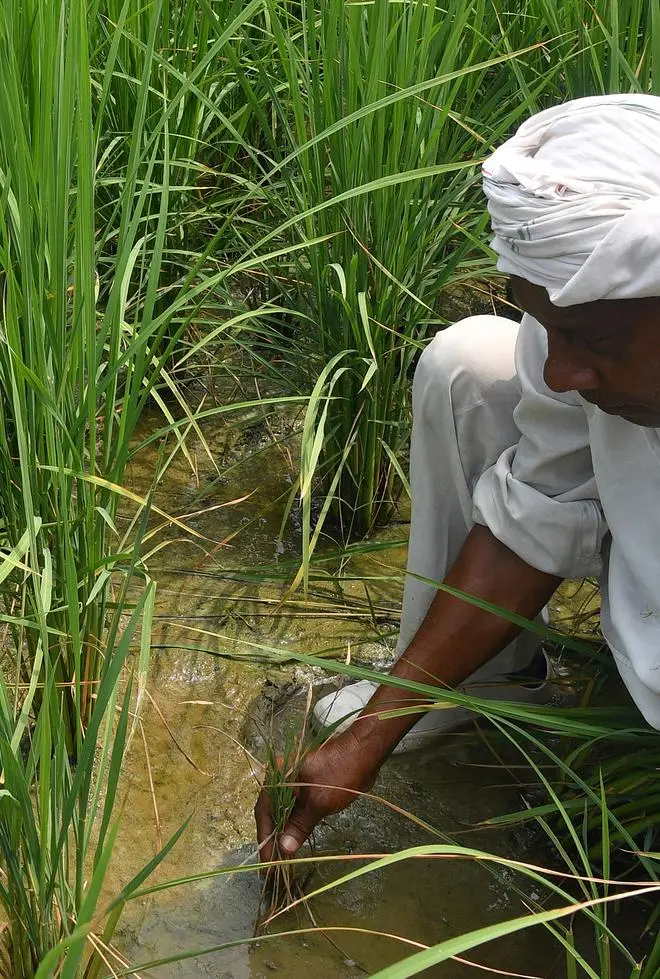The Centre’s team has submitted its preliminary assessment on the disease, which has now been confirmed as virus, that has dwarfed some non-basmati and basmati plants in Haryana and Punjab, and it apprehends that there may be net loss of production in 3,000 to 5,000 hectares area under paddy planted in this season. But farmers in Haryana are worried fearing for the healthy standing crop and praying for its safety even as they reconciled to have lower yield.
Test methods and results
“Our team has reported that the disease has been found in select fields and not in every paddy/basmati field. The intensity is not so significant, though the issue is serious,” said A K Singh, agriculture commissioner. The disease is seen to be more in fields where transplanting was done before June 25, when the temperature was high.
The test report on the disease has been out with both Punjab Agricultural University (PAU) and Indian Agricultural Research Institute (IARI) confirming the dwarfing has been caused by a virus and not due to bacteria or other infection.
“We have confirmed beyond doubt using multiple methods, the Southern Rice Black Streaked Dwarf Virus (SRBSDV), inially found in Fiji, as the cause of stunting and white backed plant hopper (WBPH) is vector. Also, in WBPH collected from infected plants on site, real time PCR has categorically shown presence of SRBSDV,” said IARI’s director Ashok Kumar Singh.
Polymerase chain reaction (PCR) is a test in which DNA of the infected plants are amplified to confirm the presence of a virus. Unless there is a virus, it will not be amplified, Singh said adding, it has also been found that the virus is not present in seeds of infected plants.
“Milky grains from infected plants were also subjected to real time PCR using same primers, with no detection even after 40 cycles, which rules our possibility of seed transmission, but we will still advise farmers and seed growers not to use infected crop for seed purpose and advise state government not to certify such plot for seed production,” he said. “We have advised farmers to use Pexalon, Chess, Token, Osheen insecticide with various technicals to effectively control WBPH,” he added.
PAU has confirmed the SRBSDV virus a day earlier behind the stunting of paddy plants in Punjab. SRBSDV is transmitted by WBPH in persistent circulative and propagative manner, according to PAU, which also ruled out nutrition deficiency as a cause of the dwarfing.

The unknown disease continues to spread to healthy plants in one field in Teha village, Haryana where Pusa Basmati 1121 has been grown by Rajpal Tyagi, a farmer who grows only paddy and potato | Photo Credit: KAMAL NARANG
Worried farmers
Rajpal Tyagi, a farmer of Teha village near Gannaur, Haryana, is worried about the healthy crops and not sure what to do to prevent the spread of the disease. Tyagi, who has taken up paddy in about 40 acres, had contacted local officials a month back after noticing the disease but there was no solution. On the advice of a local input retailer, he even sprayed copper oxide to control the disease, but could not succeed.

A farmer in Teha village in Sonipat, Haryana looking at the staunted plant in the paddy field where Pusa Basmati 1121 has been grown at Sonipat, Haryana | Photo Credit: KAMAL NARANG
“Maximum damage in has been found in my field where Pusa Basmati 1121 has been planted with the disease is spreading from one plant to another and one field to other. We have been advised to keep the field dry to contain the disease, but we need to water the plants as we cannot leave them to dry,” Tyagi said.
Maximum paddy field in Sonipat and Panipat are found to have infected plants to some extent, at least 1-2 per cent. IARI’s Singh said the disease has not affected all areas under paddy even in Haryana and Punjab, and the extent of damage is 5-15 per cent of the sown-area in a field wherever it has affected.
“About 10 per cent of the plants in a field where transplanting was done on June 24, and it is less than 5 per cent where transplanting was done on July 12. Incidentally, both the fields have Pusa Basmati 1692,” said Ashok Antil of Deepalpur village in Haryana’s Sonipat district, which was also visited for testing samples.
“I was not aware of it until 28-30 days when the plants were small, but soon realised there is something wrong. As there is no solution since no one knows about the disease, I have not used any pesticide. If the yield drops substantially, I will not grow PB 1692 next year and will opt for some other basmati variety like PB 1718,” said Antil, who always prefers to try new varieties.
An official of the state agriculture department said, “Wherever the disease has been diagnosed, the extent of dwarfing is 1-10 per cent. We have been making farmers aware to go inside the field and check if any plant has been dwarfed since most of them monitor from outside.”









Comments
Comments have to be in English, and in full sentences. They cannot be abusive or personal. Please abide by our community guidelines for posting your comments.
We have migrated to a new commenting platform. If you are already a registered user of TheHindu Businessline and logged in, you may continue to engage with our articles. If you do not have an account please register and login to post comments. Users can access their older comments by logging into their accounts on Vuukle.